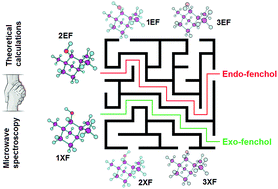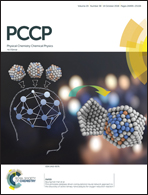Identification of the maze in the conformational landscape of fenchol†
Abstract
The rotational spectrum of the bicyclic molecule fenchol (C10H18O, 1,3,3-trimethylbicyclo[2.2.1]heptan-2-ol) – a biogenic volatile organic compound – was recorded in the gas phase using an impulse Fourier transform microwave spectrometer coupled to a supersonic jet expansion over the 2–20 GHz range. Quantum chemical calculations were performed to characterize the conformational landscape of the two diastereoisomers, endo-fenchol and exo-fenchol, with respect to the orientation of the hydroxyl group. The three most stable structures for each diastereoisomer were optimized at the MP2/6-311++G(2df,p) level of theory. Two of them were found to be very close in energy. Molecular parameters obtained from the analysis of observed signals led to the observation of one conformer per diastereoisomer. For the endo-fenchol molecule the rs geometry associated with the hydroxyl group was obtained, from the observation and analysis of the rotational spectra associated with the deuterated hydroxyl group. The nuclear quadrupolar hyperfine signature was identified. The hydroxyl group was found to be oriented into the direction of the methyl groups attached to C3, for the more stable conformer of endo-fenchol. For exo-fenchol, it is oriented into the methyl group attached to C1.



 Please wait while we load your content...
Please wait while we load your content...